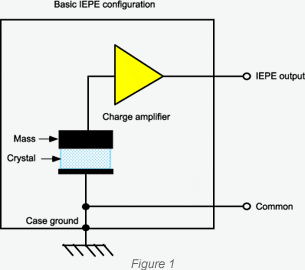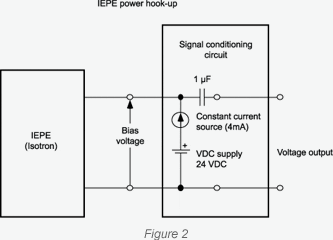Question
We have installed several Endevco® (IEPE) accelerometers within our test structure. Is it possible to use resistance measurements to check whether they are wired correctly? Can you recommend how to properly verify accelerometer functionality?

Inside IEPE:
Integrated electronics piezoelectric, or IEPE, accelerometers are offered by Endevco under the trade name of Isotron®. Their distinguishing feature is their integral electronic impedance converter, which eliminates the need for an external charge amplifier. Their integral electronics are compatible with the same industry standard IEPE current sources built into many FFT analyzers and data acquisition systems. They can also drive long cables with minimal noise distortion and pick-up.
Figure 1 shows the basic configuration of a case grounded IEPE accelerometer.
As illustrated in Figure 1, the lower side of the piezoelectric crystal is connected to the case, while the upper side (hot side) is connected to the mass. The charge output of the crystal is connected internally to the charge amplifier input. The charge amplifier output is brought out to the connector pin as the main accelerometer output. Available lines for resistance measurements are both the IEPE output and the signal return line, also known as the common line.

Answer
An ohmmeter may be used to detect whether wiring is shorted, open or whether there is gross isolation failure.
A low-voltage ohmmeter can be connected at both the IEPE output and the signal return line. Resistance measurements between the IEPE output and the common line can detect dead short, in which case, resistance is practically zero. They can also detect open circuit conditions, which have extremely high resistance. If the accelerometer's signal return is isolated from ground, resistance measurements between the signal lines and the shield ground can also detect gross isolation failure if the resistance reading is low. Please also note that any readings between the IEPE output and the common line will most likely indicate that the wiring between them forms a complete circuit.
An ohmmeter cannot be used to directly verify IEPE accelerometer functionality.
In good working IEPE accelerometers, resistance readings can vary widely and may exhibit diode effects, particularly within those accelerometers that are further equipped with Transducer Electronic Data Sheet (TEDS) capabilities. For example, one polarity that reads 50,000 ohms may read 350 ohms in reversed polarity (reversing the ohmmeter test leads). These readings are neither consistent nor repeatable unit-to-unit, even within the same lots of accelerometers. In addition, the selection of ohmmeter type, such as analog or digital, typically accounts for wide variations in reading results. The reason for such variations is that the physical parameter measured by the ohmmeter is resistance of an unbiased output active device of the charge amplifier output stage. As such, it is not possible to reliably test IEPE accelerometer functionality using resistance measurement methodologies.

Testing IEPE accelerometer functionality:
The only true and reliable means of testing IEPE accelerometer functionality is to power up the accelerometer using a constant current source, such as the Endevco® model 4416B, or typical setup, as shown in Figure 2. Once the constant current source is applied, measurement of the quiescent bias voltage across accelerometer lines allows for an accurate check as to whether the voltage reading is in specification. The bias reading of 0-2 Vdc indicates a bad output stage, while bias reading of 20-24 Vdc (with 24 Vdc compliance voltage) indicates a bad input stage. In addition, if there is a means of physically tapping the accelerometer within this setup, the output signal from the "tap" can be monitored using an oscilloscope. A pulse can be observed at the oscilloscope display while the accelerometer is being tapped. For very low output accelerometers, the input vertical gain of the oscilloscope may need to be increased until the output is viewable.